A Robust Formulation Model for Multi-Period Failure Restoration Problems in Integrated Energy Systems
Abstract
:1. Introduction
- (1)
- Proposing a three-stage failure restoration process, including the action sequence of switchgear, so in this way the feasibility of restoration results can be ensured;
- (2)
- Modeling the failure restoration problem of IEGS as a multi-period mixed integer linear problem, considering the temporal characteristics of various devices, including DGs, BSS, GSS and line/pipeline switchgear;
- (3)
- Considering the bi-directional coupling of IEGS, the GFT and P2G are coordinated to achieve the failure restoration, and the reliability of the IEGS is improved;
- (4)
- Proposing a new modeling method for radial topology constraints towards failure restoration;
- (5)
- By introducing the linearization technique, the nonlinear mathematical model of the failure restoration is formulated into a mixed-integer linear programming problem, which can be solved by an off-the-shelf commercial solver;
- (6)
- The Column & Constraint Generation (C&CG) [42] algorithm is used to solve the three-layer robust model. A modified 13-6-node IEGS is used as a case to verify the effectiveness of the proposed model.
2. Deterministic Model Formulation
2.1. Introduction to Failure Restoration
2.2. Objective of the Failure Restoration Model
- (1)
- The topology of the electric network and the natural gas network maintain a radial operation, in which the energy flow is bi-directional;
- (2)
- The transmission network cannot supply energy to the distributed electric and natural gas network. The IEGS needs to perform a local failure restoration. It is assumed that the IEGS can maintain the islanded operation before the fault is repaired.
- (3)
- The remote terminal units and the communication networks are not affected by the disaster which means they can operate normally within the restoration process.
2.3. Modelling of the Electric Network
2.4. Modelling of the Natural Gas Network
2.5. Topology Constraints
3. Robust Model Formulation
4. Case Study
4.1. Simulation Parameters
4.2. Failure Restoration Process Analysis
4.3. Comparison of Different Radial Topology Constraints
4.4. Comparison of Deterministic and Robust Model
5. Conclusions
Author Contributions
Funding
Conflicts of Interest
References
- Widl, E.; Tobias, J.; Daniel, S.; Sebastien, N.; Daniele, B.; Sawsan, H.; Tae-Gil, N.; Olatz, T.; Anett, S.; Hans, A. Studying the potential of multi-carrier energy distribution grids: A holistic approach. Energy 2018, 153, 519–529. [Google Scholar] [CrossRef]
- Krause, T.; Andersson, G.; Frohlich, K.; Vaccaro, A. Multiple-energy carriers: Modeling of production delivery and consumption. Proc. IEEE 2011, 99, 15–27. [Google Scholar] [CrossRef]
- Wang, D.; Liu, L.; Jia, H.; Wang, W.; Zhi, Y.; Meng, Z.; Zhou, B. Review of key problems related to integrated energy distribution systems. CSEE J. Power Energy Syst. 2018, 4, 130–145. [Google Scholar] [CrossRef]
- Ceseña, E.A.M.; Mancarella, P. Energy Systems Integration in Smart Districts: Robust Optimisation of Multi-Energy Flows in Integrated Electricity, Heat and Gas Networks. IEEE Trans. Smart Grid 2019, 10, 1122–1131. [Google Scholar] [CrossRef]
- Shahidehpour, M.; Fu, Y.; Wiedman, T. Impact of Natural Gas Infrastructure on Electric Power Systems. Proc. IEEE 2005, 93, 1042–1056. [Google Scholar] [CrossRef]
- He, Y.; Shahidehpour, M.; Li, Z.; Guo, C.; Zhu, B. Robust Constrained Operation of Integrated Electricity-Natural Gas System Considering Distributed Natural Gas Storage. IEEE Trans. Sustain. Energy 2018, 9, 1061–1071. [Google Scholar] [CrossRef]
- He, Y.; Yan, M.; Shahidehpour, M.; Li, Z.; Guo, C.; Wu, L.; Ding, Y. Decentralized Optimization of Multi-Area Electricity-Natural Gas Flows Based on Cone Reformulation. IEEE Trans. Power Syst. 2018, 33, 4531–4542. [Google Scholar] [CrossRef]
- Zhang, Y.; He, Y.; Guo, C.; Shahidehpour, M.; Wang, C. Synergistic Integrated Electricity-Natural Gas System Operation with Demand Response. In Proceedings of the 2018 IEEE Power & Energy Society General Meeting (PESGM), Portland, OR, USA, 5–9 August 2018; pp. 1–5. [Google Scholar]
- EIA. Annual Energy Review. 2018. Available online: https://www.eia.gov/totalenergy/data/annual (accessed on 4 July 2019).
- Li, G.; Zhang, R.; Jiang, T.; Chen, H.; Bai, L.; Li, X. Security-constrained bi-level economic dispatch model for integrated natural gas and electricity systems considering wind power and power-to-gas process. Appl. Energy 2016, 194, 696–704. [Google Scholar] [CrossRef]
- Clegg, S.; Mancarella, P. Integrated Modeling and Assessment of the Operational Impact of Power-to-Gas (P2G) on Electrical and Gas Transmission Networks. IEEE Trans. Sustain. Energy 2015, 6, 1234–1244. [Google Scholar] [CrossRef]
- Li, Y.; Liu, W.; Shahidehpour, M.; Wen, F.; Wang, K.; Huang, Y. Optimal Operation Strategy for Integrated Natural Gas Generating Unit and Power-to-Gas Conversion Facilities. IEEE Trans. Sustain. Energy 2018, 9, 1870–1879. [Google Scholar] [CrossRef]
- Huang, Z.; Wang, C.; Zhu, T.; Nayak, A. Cascading failures in smart grid: Joint effect of load propagation and interdependence. IEEE Access 2015, 3, 2520–2530. [Google Scholar] [CrossRef]
- Song, J.; Cotilla-Sanchez, E.; Ghanavati, G.; Hines, P.D.H. Dynamic Modeling of Cascading Failure in Power Systems. IEEE Trans. Power Syst. 2016, 31, 2085–2095. [Google Scholar] [CrossRef]
- Adibi, M.M.; Fink, L.H. Overcoming restoration challenges associated with major power system disturbances—Restoration from cascading failures. IEEE Power Energy Mag. 2006, 4, 68–77. [Google Scholar] [CrossRef]
- Cai, Y.; Cao, Y.; Li, Y.; Huang, T.; Zhou, B. Cascading Failure Analysis Considering Interaction Between Power Grids and Communication Networks. IEEE Trans. Smart Grid 2016, 7, 530–538. [Google Scholar] [CrossRef]
- National Oceanic and Atmospheric Administration, Billion-Dollar Weather and Climate Disasters. 2014. Available online: http://www.ncdc.noaa.gov/billions/overview (accessed on 4 July 2019).
- Campbell, R.J. Weather-Related Power Outages and Electric System Resiliency; Congressional Research Service: Washington, DC, USA, 2012. [Google Scholar]
- Wang, Y.; Chen, C.; Wang, J.; Baldick, R. Research on resilience of power systems under natural disasters—A review. IEEE Trans. Power Syst. 2016, 31, 1604–1613. [Google Scholar] [CrossRef]
- Li, G.; Bie, Z.; Kou, Y.; Jiang, J.; Bettinelli, M. Reliability evaluation of integrated energy systems based on smart agent communication. Appl. Energy 2016, 167, 397–406. [Google Scholar] [CrossRef]
- Lei, Y.; Hou, K.; Wang, Y.; Jia, H.; Zhang, P.; Mu, Y.; Jin, X.; Sui, B. A new reliability assessment approach for integrated energy systems: Using hierarchical decoupling optimization framework and impact-increment based state enumeration method. Appl. Energy 2018, 210, 1237–1250. [Google Scholar] [CrossRef]
- Bai, L.; Li, F.; Jiang, T.; Jia, H. Robust scheduling for wind integrated energy systems considering gas pipeline and power transmission N-1 contingencies. IEEE Trans. Power Syst. 2017, 32, 1582–1584. [Google Scholar] [CrossRef]
- Correa-Posada, C.M.; Sanchez-Martin, P. Security-constrained optimal power and natural-gas flow. IEEE Trans. Power Syst. 2014, 29, 1780–1787. [Google Scholar] [CrossRef]
- Wang, C.; Wei, W.; Wang, J.; Liu, F.; Qiu, F.; Correa-Posada, C.M.; Mei, S. Robust Defense Strategy for Gas-Electric Systems Against Malicious Attacks. IEEE Trans. Power Syst. 2017, 32, 2953–2965. [Google Scholar] [CrossRef]
- He, C.; Dai, C.; Wu, L.; Liu, T. Robust Network Hardening Strategy for Enhancing Resilience of Integrated Electricity and Natural Gas Distribution Systems Against Natural Disasters. IEEE Trans. Power Syst. 2018, 33, 5787–5798. [Google Scholar] [CrossRef]
- Shirmohammadi, D. Service restoration in distribution networks via network reconfiguration. IEEE Trans. Power Deliv. 1992, 7, 952–958. [Google Scholar] [CrossRef]
- Hsu, Y.Y.; Huang, H.-M.; Kuo, H.-C.; Peng, S.K.; Chang, C.W.; Chang, K.J.; Yu, H.S.; Chow, C.E.; Kuo, R.T. Distribution system service restoration using a heuristic search approach. IEEE Trans. Power Deliv. 1992, 7, 734–740. [Google Scholar] [CrossRef]
- Tsai, M.S. Development of an object-oriented service restoration expert system with load variations. IEEE Trans. Power Syst. 2008, 23, 219–225. [Google Scholar] [CrossRef]
- Shin, D.J.; Kim, J.O.; Kim, T.K.; Choo, J.B.; Singh, C. Optimal service restoration and reconfiguration of network using Genetic-Tabu algorithm. Electr. Power Syst. Res. 2004, 71, 145–152. [Google Scholar] [CrossRef]
- Tian, Y.; Lin, T.; Zhang, M.; Xu, X. A new strategy of distribution system service restoration using distributed generation. In Proceedings of the 2009 International Conference on Sustainable Power Generation and Supply, SUPERGEN ’09, Nanjing, China, 6–7 April 2009; pp. 1–5. [Google Scholar]
- Pérez-Guerrero, R.; Heydt, G.T.; Jack, N.J.; Keel, B.K.; Castelhano, A.R. Optimal restoration of distribution systems using dynamic programming. IEEE Trans. Power Deliv. 2008, 23, 1589–1596. [Google Scholar] [CrossRef]
- Chen, B.; Ye, Z.; Chen, C.; Wang, J. Toward a MILP Modeling Framework for Distribution System Restoration. IEEE Trans. Power Syst. 2019, 34, 1749–1760. [Google Scholar] [CrossRef]
- Chen, B.; Chen, C.; Wang, J.; Butler-Purry, K.L. Sequential Service Restoration for Unbalanced Distribution Systems and Microgrids. IEEE Trans. Power Syst. 2018, 33, 1507–1520. [Google Scholar] [CrossRef]
- Watanabe, I.; Nodu, M. A genetic algorithm for optimizing switching sequence of service restoration in distribution systems. In Proceedings of the 2004 Congress on Evolutionary Computation (IEEE Cat. No.04TH8753), Portland, OR, USA, 19–23 June 2004; Volume 2, pp. 1683–1690. [Google Scholar]
- Chen, C.; Wang, J.; Dan, T. Modernizing Distribution System Restoration to Achieve Grid Resiliency Against Extreme Weather Events: An Integrated Solution. Proc. IEEE 2017, 105, 1267–1288. [Google Scholar] [CrossRef]
- Chen, C.; Wang, J.; Qiu, F.; Zhao, D. Resilient Distribution System by Microgrids Formation After Natural Disasters. IEEE Trans. Smart Grid 2016, 7, 958–966. [Google Scholar] [CrossRef]
- Farzin, H.; Fotuhi-Firuzabad, M.; Moeini-Aghtaie, M. Enhancing Power System Resilience Through Hierarchical Outage Management in Multi-Microgrids. IEEE Trans. Smart Grid 2016, 7, 2869–2879. [Google Scholar] [CrossRef]
- Strbac, G.; Hatziargyriou, N.; Lopes, J.P.; Moreira, C.; Dimeas, A.; Papadaskalopoulos, D. Microgrids: Enhancing the resilience of the European megagrid. IEEE Power Energy Mag. 2015, 13, 13–43. [Google Scholar] [CrossRef]
- Chen, K.; Wu, W.; Zhang, B.; Sun, H. Robust Restoration Decision-Making Model for Distribution Networks Based on Information Gap Decision Theory. IEEE Trans. Smart Grid 2015, 6, 587–597. [Google Scholar] [CrossRef]
- Chen, X.; Wu, W.; Zhang, B. Robust Restoration Method for Active Distribution Networks. IEEE Trans. Power Syst. 2016, 31, 4005–4015. [Google Scholar] [CrossRef]
- Baran, M.E.; Wu, F.F. Network reconfiguration in distribution systems for loss reduction and load balancing. IEEE Trans. Power Deliv. 1989, 4, 1401–1407. [Google Scholar] [CrossRef]
- Zeng, B.; Zhao, L. Solving two-stage robust optimization problems using a column-and-constraint generation method. Oper. Res. Lett. 2013, 41, 457–461. [Google Scholar] [CrossRef]
- Elkhatib, M.E.; El-Shatshat, R.; Salama, M.M.A. Novel Coordinated Voltage Control for Smart Distribution Networks with DG. IEEE Trans. Smart Grid 2011, 2, 598–605. [Google Scholar] [CrossRef]
- Zeng, Q.; Fang, J.; Lia, J.; Chen, Z. Steady-state analysis of the integrated natural gas and electric power system with bi-directional energy conversion. Appl. Energy 2016, 184, 1483–1492. [Google Scholar] [CrossRef]
- De Wolf, D.; Smeers, Y. The gas transmission problem solved by an extension of the simplex algorithm. Manag. Sci. 2000, 46, 1454–1465. [Google Scholar] [CrossRef]
- Geißler, B.; Martin, A.; Morsi, A.; Schewe, L. Using Piecewise Linear Functions for Solving MINLPs. In Mixed Integer Nonlinear Programming; The IMA Volumes in Mathematics and its Applications; Lee, J., Leyffer, S., Eds.; Springer: New York, NY, USA, 2012; Volume 154. [Google Scholar]
- Correa-Posada, C.M.; Sánchez-Martín, P. Integrated power and natural gas model for energy adequacy in short-term operation. IEEE Trans. Power Syst. 2014, 30, 3347–3355. [Google Scholar] [CrossRef]
- Lu, T.; Wang, K.S. Analysis and optimization of a cascading power cycle with liquefied natural gas (LNG) cold energy recovery. Appl. Therm. Eng. 2009, 29, 1478–1484. [Google Scholar] [CrossRef]
- Bertsimas, D.; Litvinov, E.; Sun, X.A.; Zhao, J.; Zheng, T. Adaptive Robust Optimization for the Security Constrained Unit Commitment Problem. IEEE Trans. Power Syst. 2013, 28, 52–63. [Google Scholar] [CrossRef]
- Lofberg, J. YALMIP: A toolbox for modeling and optimization in MATLAB. In Proceedings of the 2004 IEEE International Conference on Robotics and Automation (IEEE Cat. No.04CH37508), New Orleans, LA, USA, 2–4 September 2004; pp. 284–289. [Google Scholar]
- CPLEX, I.B.M.I. V12. 1: User’s Manual for CPLEX. Int. Bus. Mach. Corp. 2009, 46, 157. [Google Scholar]
- IEEE PES AMPS DSAS Test Feeder Working Group. Available online: http://sites.ieee.org/pes-testfeeders/resources/ (accessed on 13 June 2019).
- Romero, R.; Franco, J.F.; Leão, F.B.; Rider, M.J.; de Souza, E.S. A New Mathematical Model for the Restoration Problem in Balanced Radial Distribution Systems. IEEE Trans. Power Syst. 2016, 31, 1259–1268. [Google Scholar] [CrossRef]








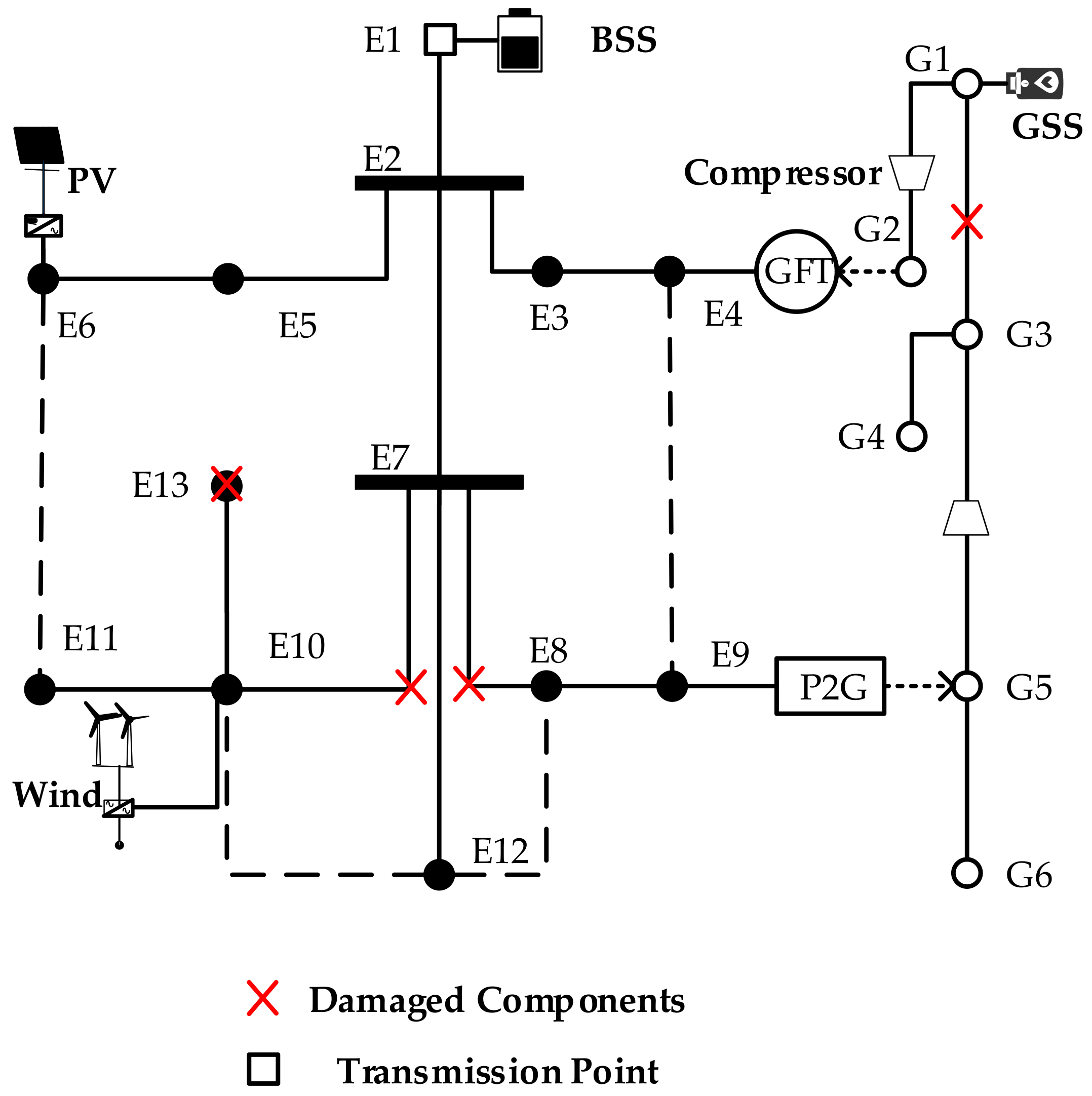
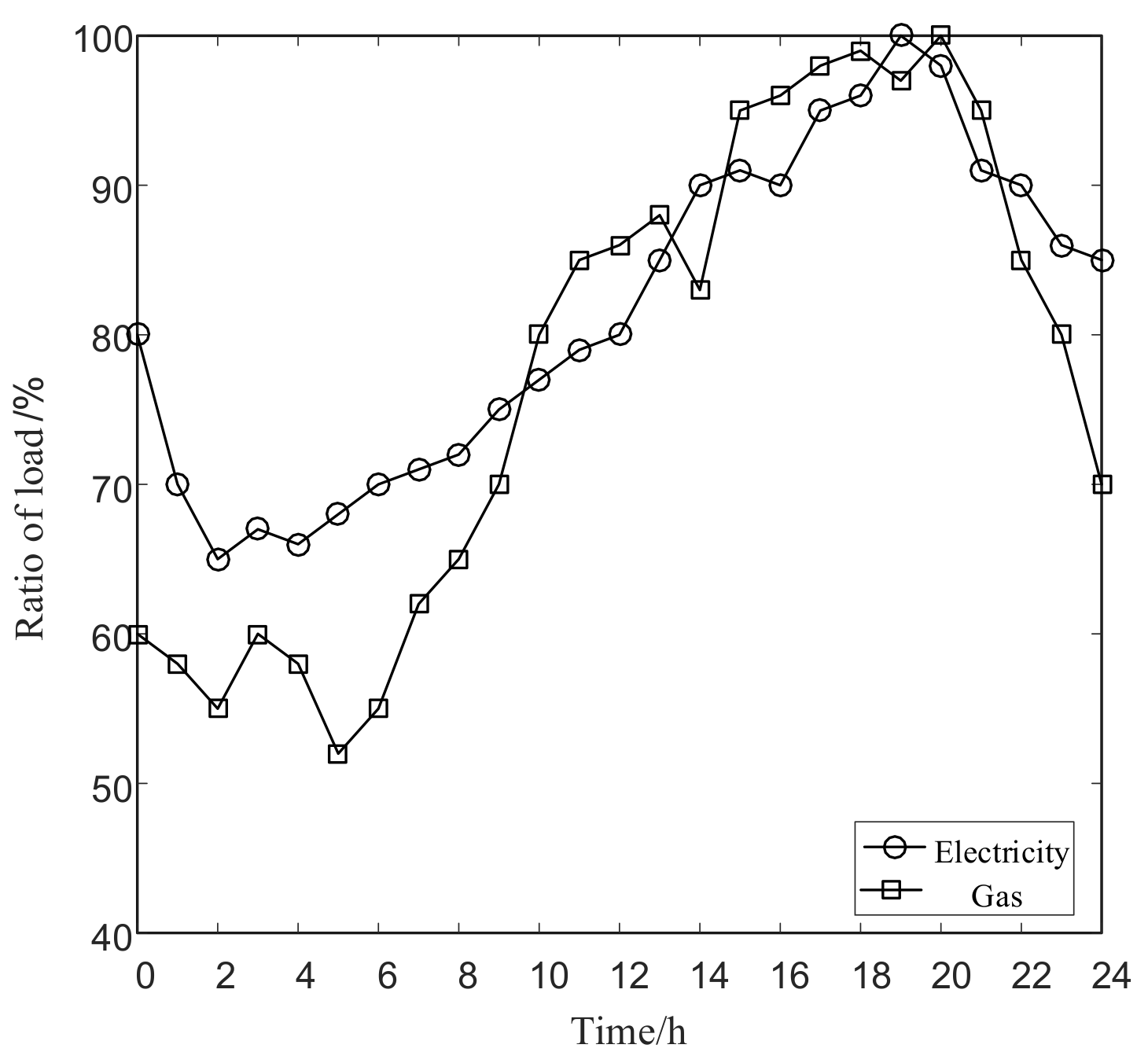

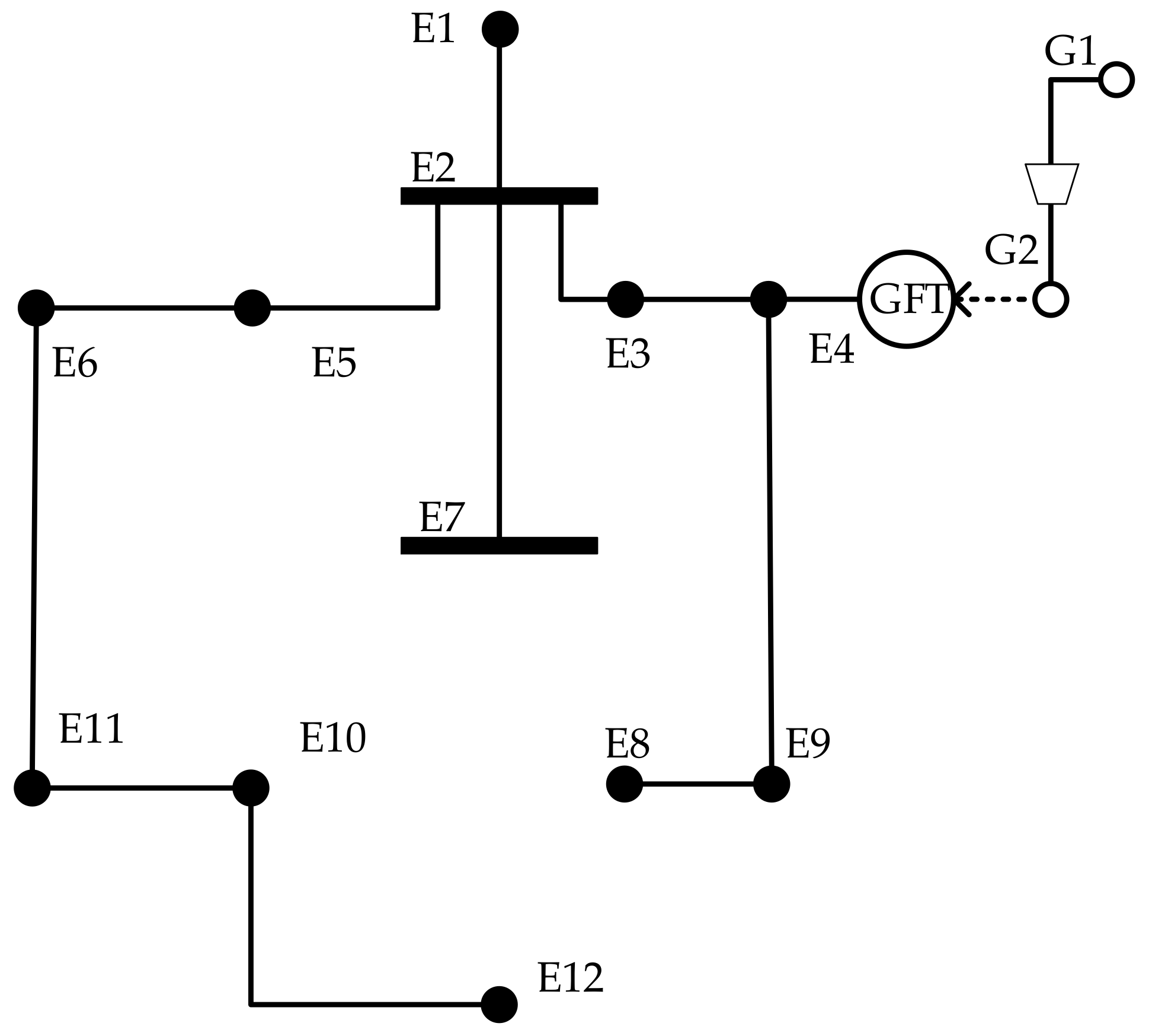
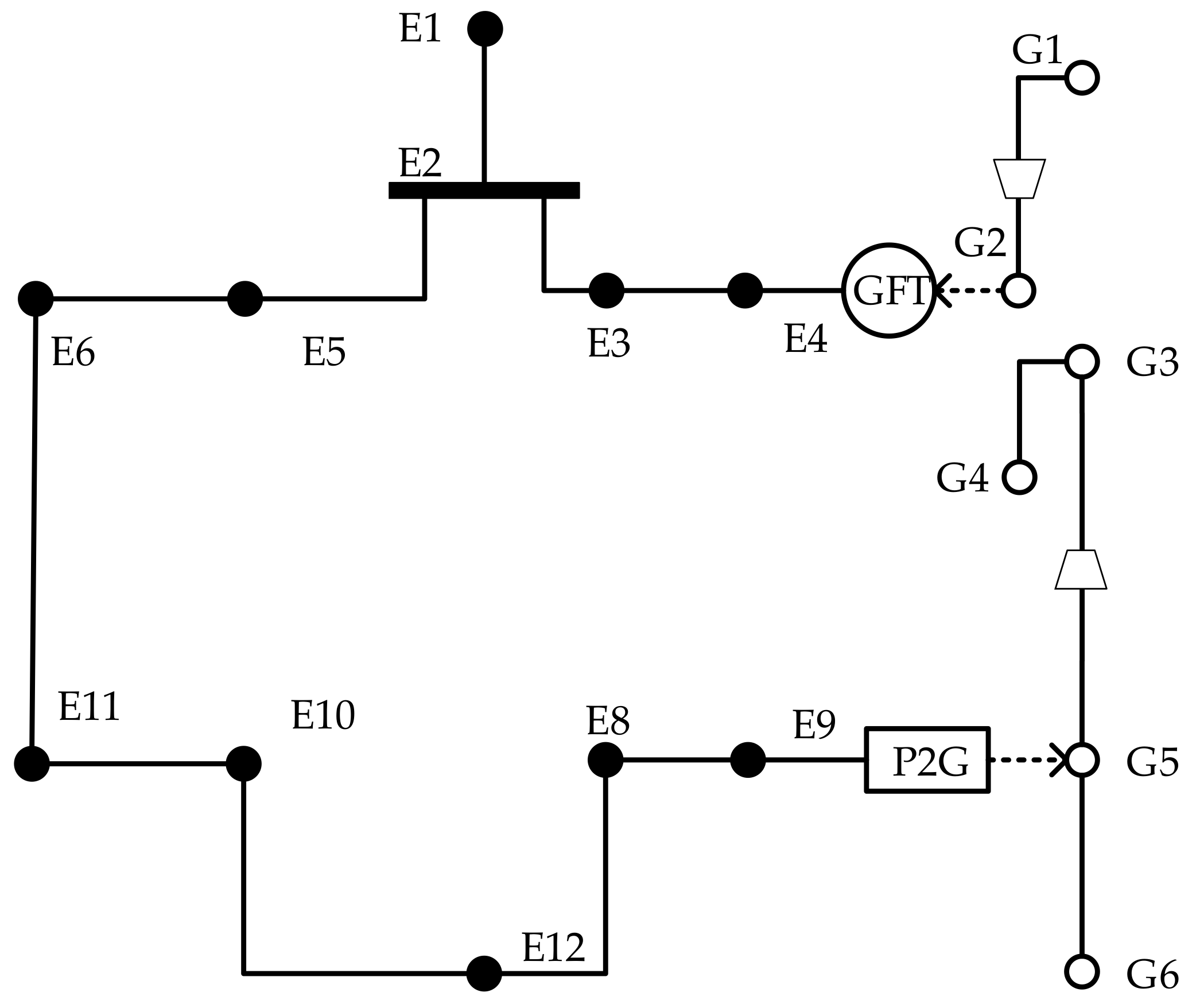
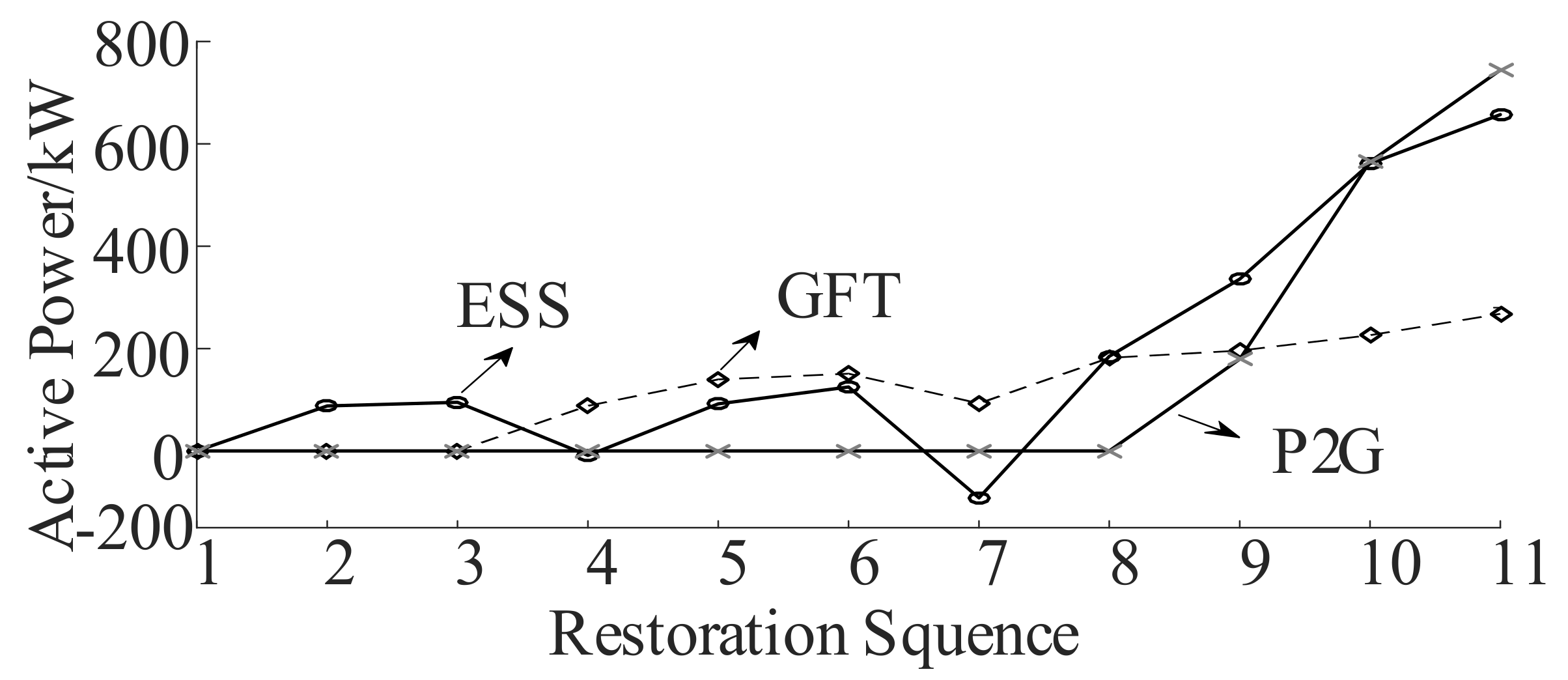
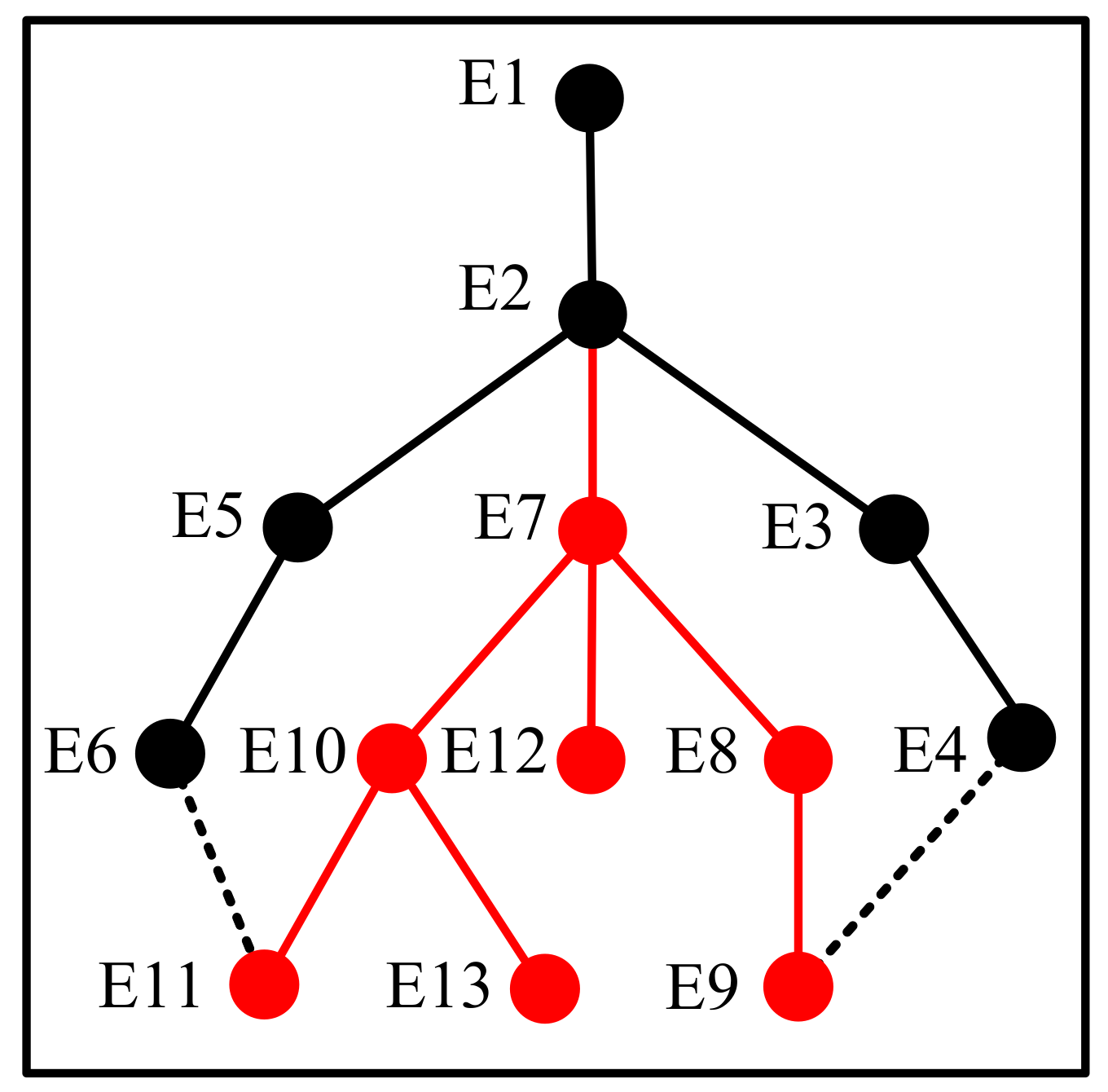


| Line Index | Starting Node | Ending Node | Length (ft) | Capacity (kVA) |
|---|---|---|---|---|
| 1 | 1 | 2 | 2000 | 1500 |
| 2 | 2 | 3 | 500 | 1000 |
| 3 | 3 | 4 | 200 | 500 |
| 4 | 2 | 5 | 500 | 1000 |
| 5 | 5 | 6 | 300 | 800 |
| 6 | 2 | 7 | 2000 | 1500 |
| 7 | 7 | 8 | 10 | 800 |
| 8 | 8 | 9 | 500 | 800 |
| 9 | 7 | 10 | 300 | 800 |
| 10 | 10 | 11 | 300 | 800 |
| 11 | 10 | 12 | 300 | 800 |
| 12 | 7 | 12 | 1000 | 1500 |
| 13 | 6 | 11 | 2000 | 800 |
| 14 | 8 | 12 | 1500 | 1000 |
| 15 | 4 | 9 | 600 | 700 |
| Node Index | Active Load (kW) | Reactive Load (kVar) | Weight Coefficient |
|---|---|---|---|
| 2 | 100 | 40 | 2.12 |
| 4 | 100 | 40 | 1.44 |
| 5 | 200 | 100 | 1.14 |
| 6 | 200 | 100 | 3.29 |
| 7 | 300 | 180 | 2.66 |
| 8 | 200 | 150 | 2.90 |
| 9 | 200 | 40 | 2.88 |
| 11 | 200 | 120 | 1.66 |
| 12 | 200 | 120 | 1.68 |
| 13 | 40 | 30 | 1.84 |
| Pipeline Index | Starting Node | Ending Node | Parameter |
|---|---|---|---|
| 1 | 1 | 2 | 1.095 |
| 2 | 1 | 3 | 1.095 |
| 3 | 3 | 4 | 1.173 |
| 4 | 3 | 5 | 1.158 |
| 5 | 5 | 6 | 1.158 |
| Load Index | Gas Load (Sm3/h) | Upper Limit of Pressure (bar) | Lower Limit of Pressure (bar) | Weight Coefficient |
|---|---|---|---|---|
| 1 | 29.8 | 75 | 20 | 5.82 0.4610 2.8390 2.7997 1.4197 2.3408 |
| 2 | 10.4 | 60 | 20 | 5.46 |
| 3 | 12.6 | 60 | 20 | 4.83 |
| 4 | 16.5 | 60 | 20 | 7.79 |
| 5 | 11.0 | 60 | 20 | 6.41 |
| 6 | 11.6 | 60 | 20 | 5.34 |
| Compressor Index | Starting Node | Ending Node | Lower Limit of Ratio | Upper Limit of Ratio |
|---|---|---|---|---|
| 1 | G1 | G2 | 1.0 | 1.3 |
| 2 | G5 | G3 | 1.0 | 1.2 |
| Electric Node | Gas Node | Upper Limit of Active Power (kW) | Efficiency | |
|---|---|---|---|---|
| GFT | E4 | G2 | 800 | 0.43 |
| P2G | E9 | G5 | 300 | 0.62 |
| Node | Initial Capacity | Limit of Capacity | Limit of Charging Rate | Limit of Discharging Rate | |
|---|---|---|---|---|---|
| BSS | E1 | 2500 kWh | 3000 kWh (kw) | 750 kW/h | 750 kW/h |
| GSS | G1 | 800 m3 | 300 m3 | 100 m3/h | 100 m3/h |
| Case | Objective Function Value | Electricity Part | Natural Gas Part | Computational Time (s) |
|---|---|---|---|---|
| 1 | 22113.58 | 17743.85 | 4369.73 | 1.022 |
| 2 | 34469.85 | 30100.12 | 4369.73 | 1.076 |
| 3 | 39874.69 | 20489.57 | 19385.12 | 2.195 |
| Step | Restored Lines | Restored Loads | ||||
|---|---|---|---|---|---|---|
| Case 1 | Case 2 | Case 3 | Case 1 | Case 2 | Case 3 | |
| 1 | - | - | - | G1 | G1 | G1 |
| 2 | (G1,G2),(E1,E2) | (G1,G2),(E1,E2) | (G1,G2),(E1,E2) | G2,E2 | G2,E2 | G2,E2 |
| 3 | (E2,E5) | (E2,E3),(E2,E5) | (E2,E3),(E2,E5) | E5 | E5 | - |
| 4 | (E5,E6) | (E3,E4),(E5,E6) | (E3,E4),(E5,E6) | E6 | E4,E6,GFT | E4,E6,GFT |
| 5 | (E6,E11) | (E4,E9),(E6,E11) | (E6,E11) | E11 | E9,E11 | E11 |
| 6 | (E11,E10) | (E2,E7) | (E11,E10) | - | E7 | E10 |
| 7 | (E10,E12) | (E9,E8),(E11,E10) | (E10,E12) | E12 | E8,E10 | E12 |
| 8 | (E12,E8) | (E10,E12) | (E12,E8),(E8,E9) | E8 | E12 | E8 |
| 9 | - | - | P2G | - | - | G5 |
| 10 | - | - | (G5, G3),(G5,G6) | - | - | G3,G6 |
| 11 | - | - | (G3,G4) | - | - | G4 |
| Case 3 (Normal) | Case 4 (Worst) | |
|---|---|---|
| Objective function | 39874.69 | 36698.21 |
| Restored electrical nodes | E2,E4,E6,E8,E9,E11,E12 | E2,E4,E6,E8, E11 |
| Restored gas nodes | G1,G2,G3,G4,G5,G6 | G1,G2,G3,G5,G6 |
| DGs Penetration | Total Restored Loads | Restored Electric Loads | Restored Gas Loads |
|---|---|---|---|
| Low Level | 41365.68 | 25893.88 | 15471.8 |
| Base Level | 39874.69 | 20489.57 | 19385.12 |
| High Level | 37689.75 | 15987.69 | 21702.06 |
| Model | Success Rate | Average Restored Power |
|---|---|---|
| Deterministic Model | 73.5% | 36587.68 |
| Robust Model | 100% | 40256.48 |
© 2019 by the authors. Licensee MDPI, Basel, Switzerland. This article is an open access article distributed under the terms and conditions of the Creative Commons Attribution (CC BY) license (http://creativecommons.org/licenses/by/4.0/).
Share and Cite
Chen, W.; Lou, X.; Guo, C. A Robust Formulation Model for Multi-Period Failure Restoration Problems in Integrated Energy Systems. Energies 2019, 12, 3673. https://doi.org/10.3390/en12193673
Chen W, Lou X, Guo C. A Robust Formulation Model for Multi-Period Failure Restoration Problems in Integrated Energy Systems. Energies. 2019; 12(19):3673. https://doi.org/10.3390/en12193673
Chicago/Turabian StyleChen, Wei, Xiansi Lou, and Chuangxin Guo. 2019. "A Robust Formulation Model for Multi-Period Failure Restoration Problems in Integrated Energy Systems" Energies 12, no. 19: 3673. https://doi.org/10.3390/en12193673




